Paper collage, Dry pastels on paper board, 30x40 inch
Enquire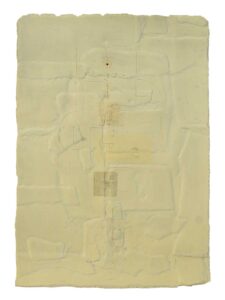

Every generation evolves by unraveling pre-existing paradigms to create their own realms. This perennial phenomenon is driven by an ambition of exploring pure realizations of the truth of our existence. In visual art, abstraction connects one to the paths of awakenings through a meditative understandings of every aspect of our living beyond received and decipherable grids of languages, signs, iconographies – both textual and visual. Our cosmos is, as we perceive it, intentionally and unintentionally, formed by structures that surround us. Unknown and visceral, abstraction acquires momentous space with a sense of immense tranquility treading new paths of aesthetic experience.
Shahanshah delves into this spiritual experience by withdrawing from the use of pigments or representative forms and motifs. The vocabulary of visuals does not create a literal meaning, it is poetic, urging one to find colors and reach the blankness of spiritual actuality, constructing and deconstructing meaning in various spaces and time. The collages are steps of realizations, beyond the meanings that we create. The artist carves out his memoirs with layers of paper overlapping each other.
Poetic Reminiscences is the expression of the artist’s need for abstraction as he questions the epistemology of rationality. The exhibition experiments with space, it is an ode to an other-worldly pilgrimage through submerged planes – it coaxes one to introspect and perhaps, transcend dimensions. As Paul Klee says, ‘Art does not reproduce the visible but makes visible’ what commonly is not seen.

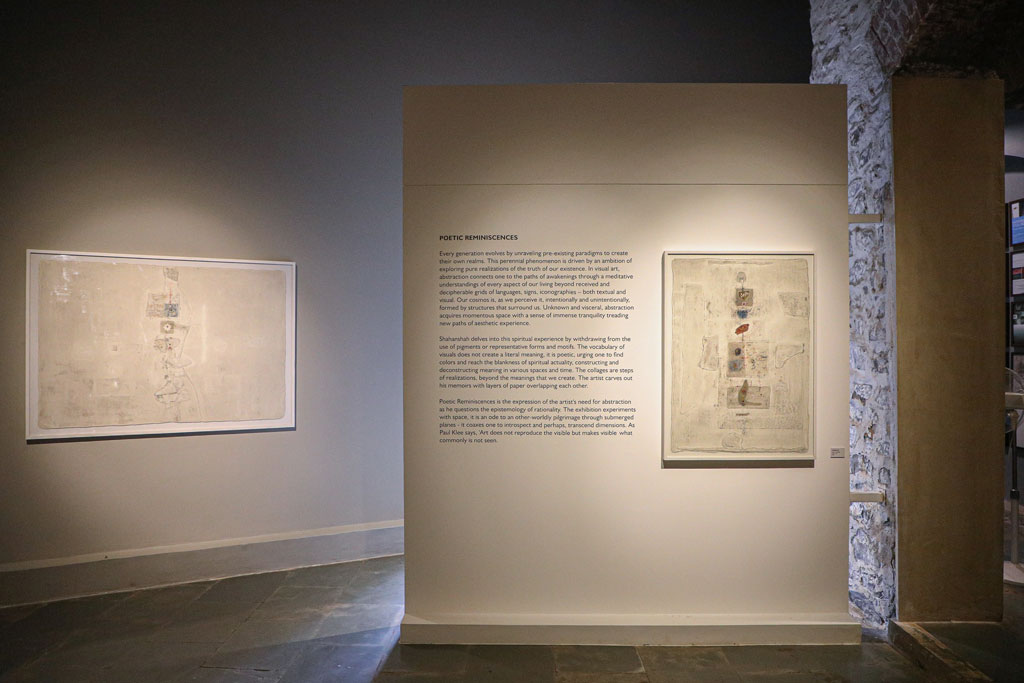
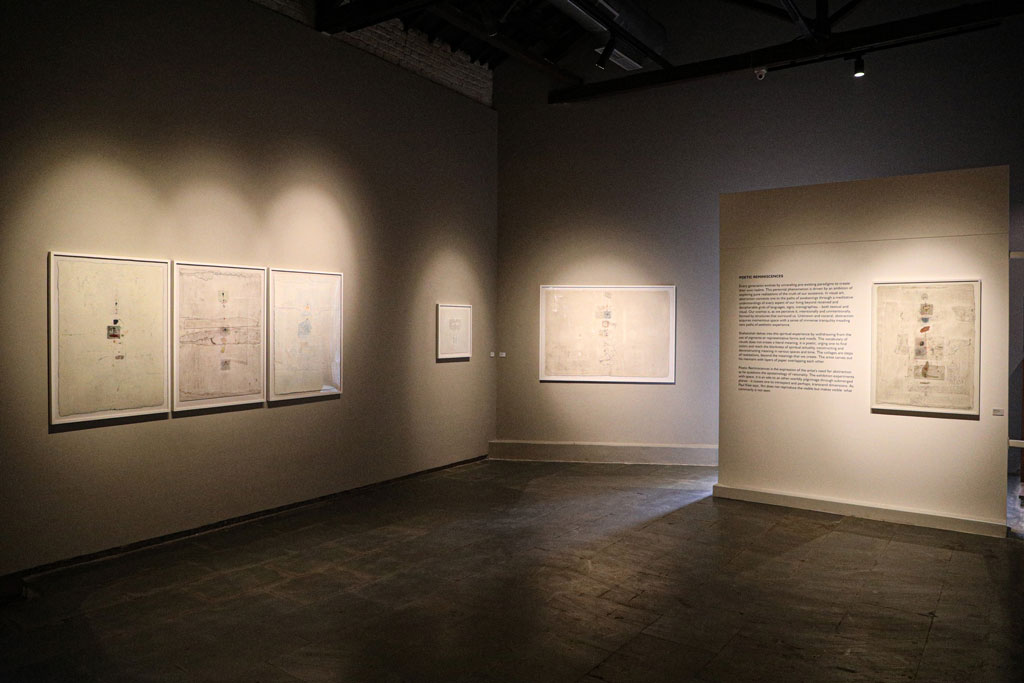
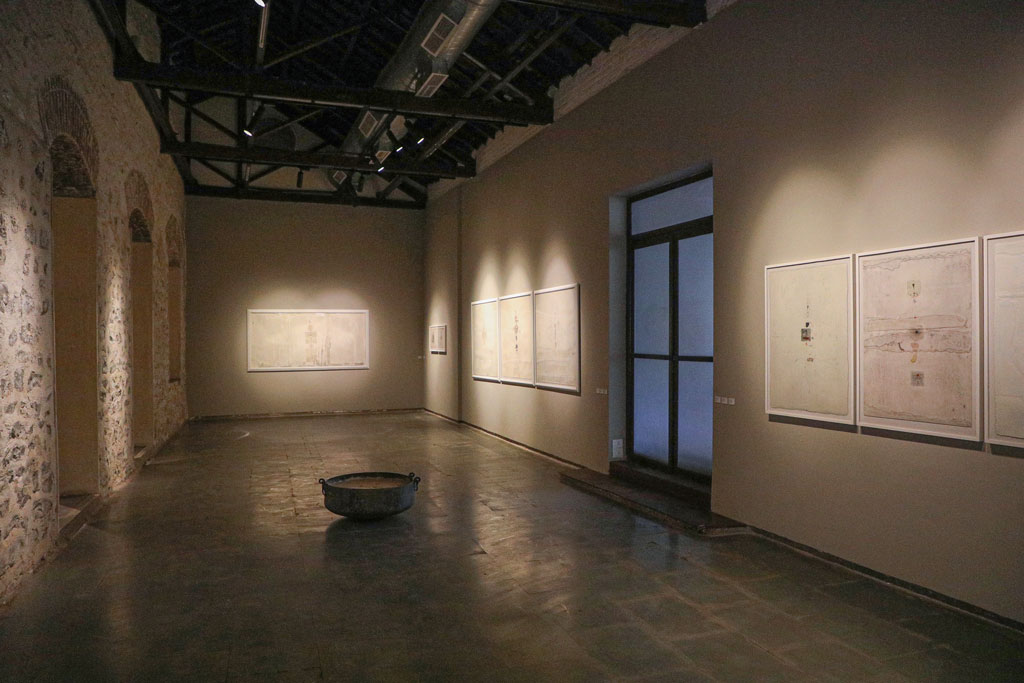

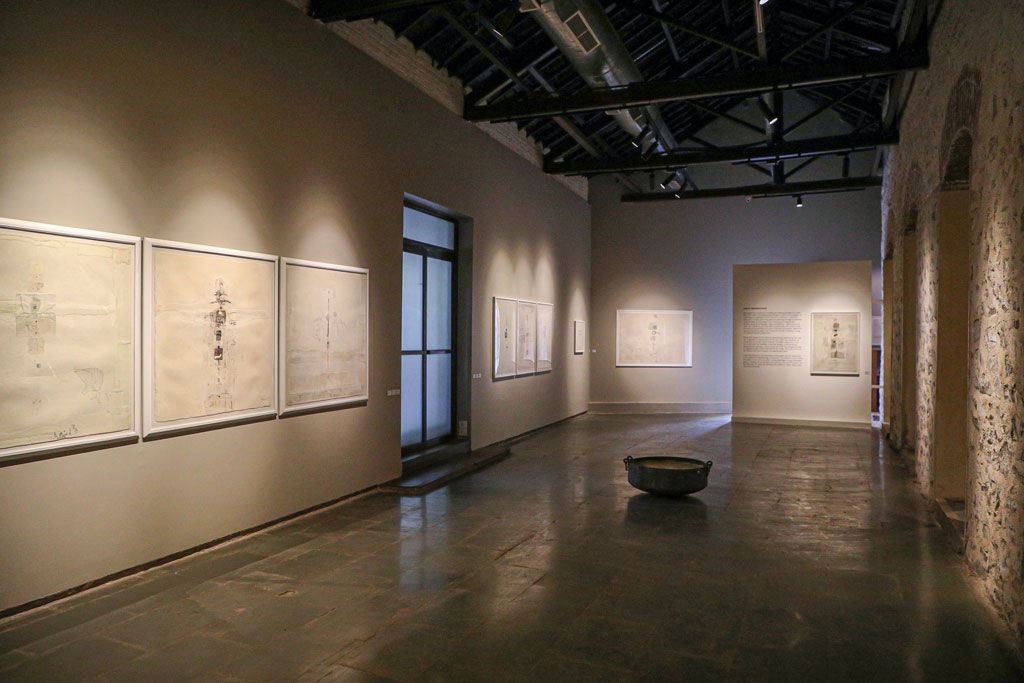


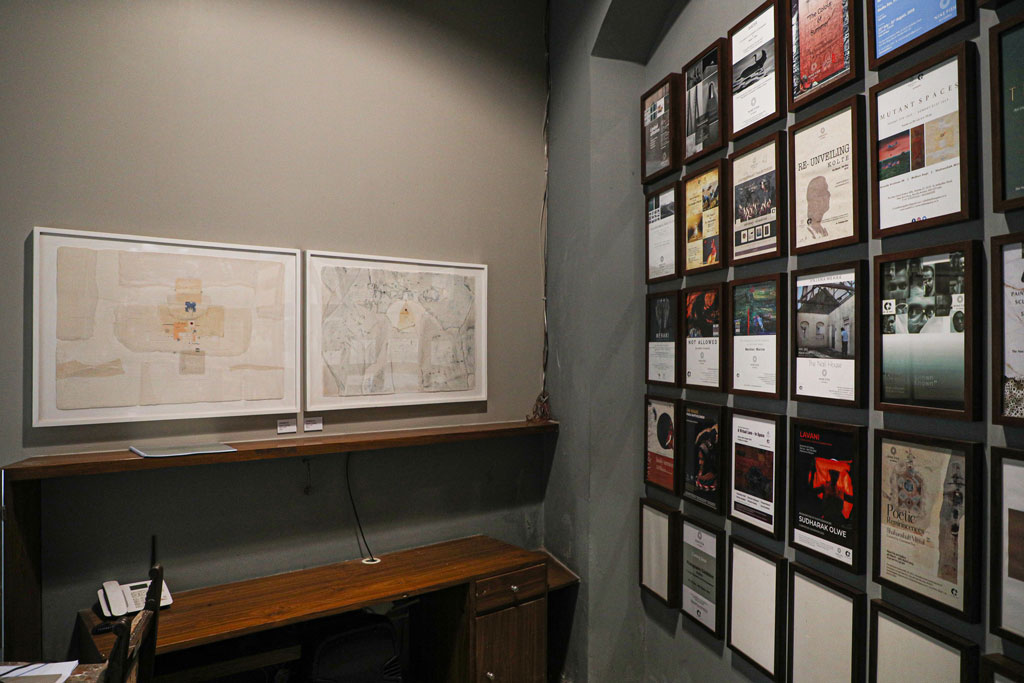

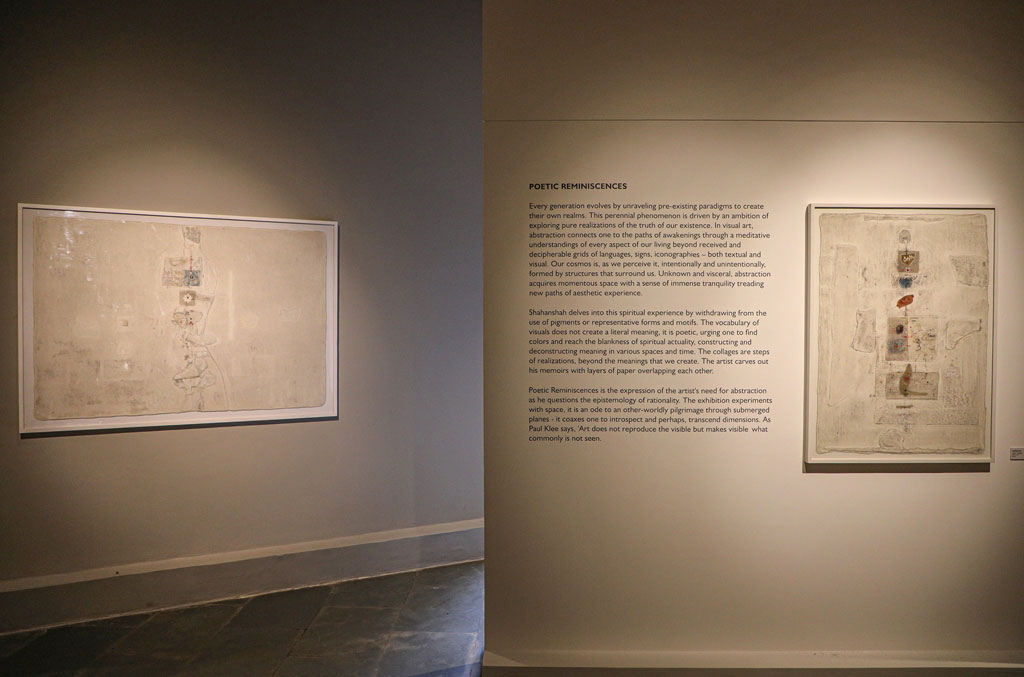
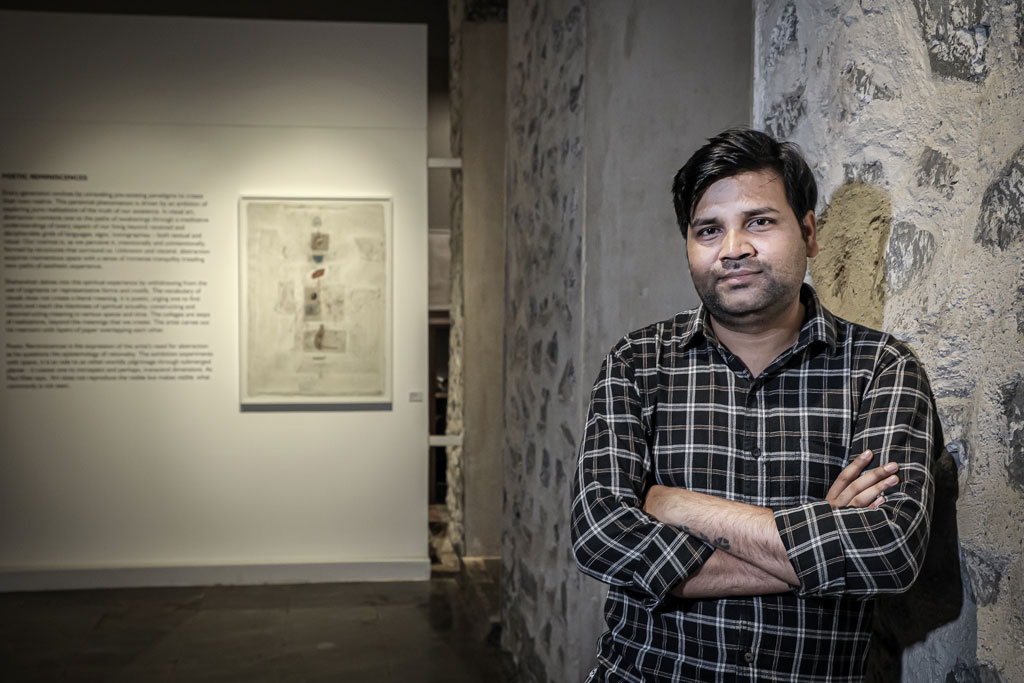
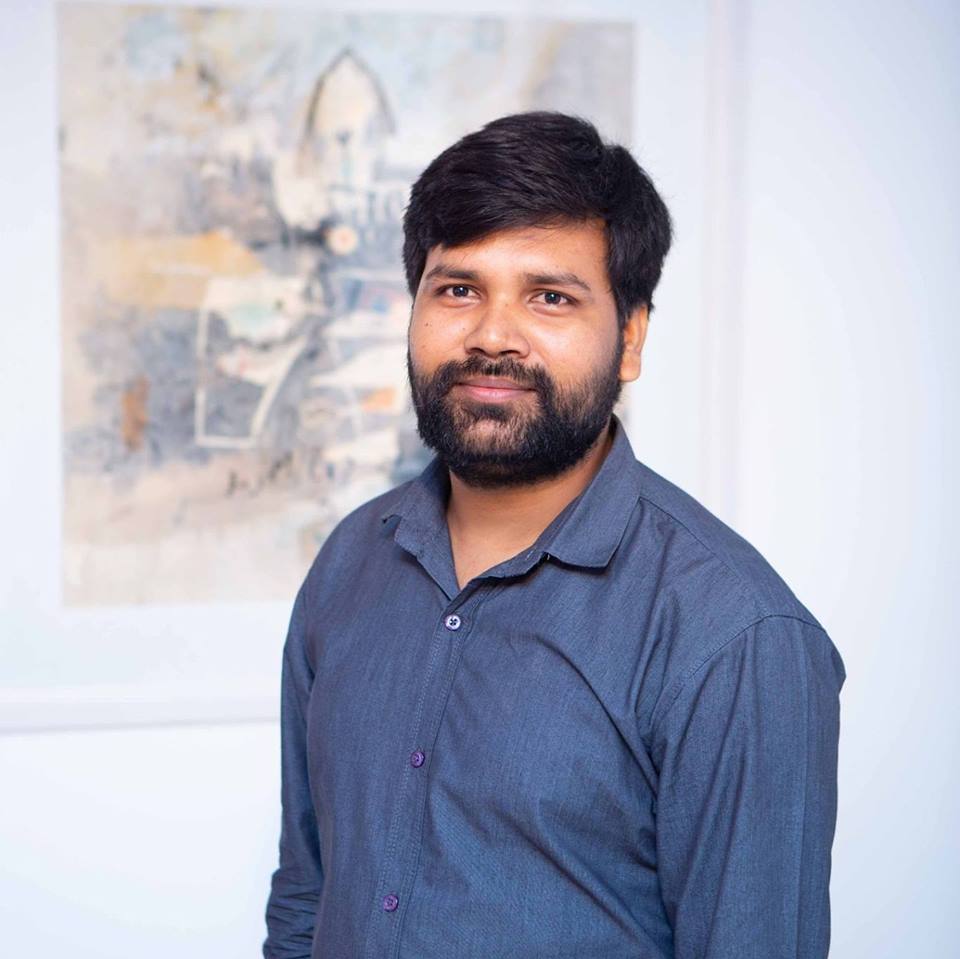
Born in Gwalior, Shahanshah grew up with four siblings. His interest in arts, or rather things other than mainstream subjects, was evident from early days. But since there was a complete lack of guidance, he was unable to meaningfully explore his creativity. It was only after his eldest sister got married to an artist that he was encouraged to take up the arts as his core vocation. The family, on guidance of his brother in-law, convinced him to study applied arts since it had better prospects of getting a well-paying job! “Though I completed the first year of my BFA, I felt applied arts was very limiting. It did not allow me the freedom of creative expression,” he says. A change in the city and school was a collective decision of the family, with the thought that this would help him complete the course. Shahanshah dutifully moved to Jabalpur for his second and third year. He took up a day-job with an agency, as was destined for him and a hope of his parents.
Within the first year of his maiden job, he left it and returned back home; he continued to be uneasy. The artist in him needed an outlet. His art teacher at his elementary school in Gwalior encouraged him to begin painting. And this time, again, to keep the family happy, he enrolled for an MFA, of course, in applied arts. He now found contentment by expressing more freely through his paintings. And when a body of work was ready, he decided to hold an exhibition at a local gallery in the city. It is here that his family was convinced that Shahanshah was destined to be an artist. He got connected to Anwar Khan, a practicing artist in Delhi, and soon moved to the city to hone his skills under his able guidance. “Meeting Anwar sir was a turning point in my career. I still remember when I first met him, he asked, ‘why art’, and I told him that I did not know why. Honestly, I still do not why,” he says. All Anwar asked him was for complete commitment for at least two-years. Anwar was spiritual in his approach. Working under his tutelage, Shahanshah too began to look ‘inward’. He saw a major shift in his work within three-months of moving to Delhi. His work in past was both, figurative and colourful. But now he began to focus on abstraction using a monochromatic palette.
In 2014, Anwar felt that Shahanshah was ready to take his works back to his home town with a show. The show was a huge success, in terms of his paintings getting acquired by collectors and also receiving positive critical feedback. “It was a matter of immense satisfaction, especially since it was not only hometown but also a small city, with very limited appreciation to fine arts,” shares Shahanshah. He continued to work back in Delhi. His sole objective was to express freely, and to get an approval of his guru. Nothing else mattered to him, and rightly so!
His debut show in Delhi was held in 2017 at the Triveni Kala Sangam. Since then, he has been invited to participate in group-shows alongside established artists and his works have found acceptance in significant collections. Shahanshah’s current work is a continuum of the journey he began four years back. He says that he does not work with a lot of thought in mind. He thoroughly enjoys the freedom and allows things to flow in a natural way. He prefers his works to remain devoid of heavy concepts and intellectual contexts, and most prefers the viewer to layer his creation with their own experiences. While most his works celebrate the formlessness, he relies on his education in the applied arts and his short stint with an advertisement agency. On closer inspection, one can see the repeated use of triangle form and grids. “We used to make colour chart manually at the agency and somehow that form itself stayed with me,” he explains. In fact, the simple dummy text of x’s and o’s, used as placeholder as a graphic designer, percolate into his works. At his studio, his constant companion is classical music.
He is intrigued by the poetry and lyrics in the songs. He recreates the words from these songs, although, there is never an intent to make it legible. The ‘forms’ appear like text but have no meaning; they do not even use a script, as such. Overall tones and textures of his canvasses appear like weathered and dilapidated walls. Shahanshah vividly recalls staying in a one-room rented apartment when he first moved to Delhi. He spent hours in the room, the walls of which were aged. “The paint of the walls was peeling off and at places explored the base plaster. The balcony had potted flowering-plants. As a result, I had these two things that I most observed. I began to enjoy the very character of the wall at one side, and beauty of the flowers on the other. Every so often, these too find their way in my works although it’s all subconscious,” he says. Even the layered paper stipes that he uses draw inspiration from the patch-up work on the walls to hide and mend cracks.
Shahansha’s works display a unique sense of balance. Several sources and references emerge when probed, but he is very certain that these are not forcefully added. The effortlessness and freedom in his work are very apparent. He adds layers, hides what does not fit-in, and declares a work complete when ‘a sense of equilibrium’ is achieved. For him, abstraction is like air. It can take any shape and form, but by itself neither has a form, nor colour. Its job is to carry the force and smell, just like his works that carry his deep sense of conviction to the viewers.


Paper collage, Dry pastels on paper board, 30x40 inch
EnquireDry pastels on paper board, 14x15 inch
EnquirePaper collage, Dry pastels on paper board, 20x20 inch
EnquirePaper collage, Dry pastels on paper board, 44x44 inch
EnquirePaper collage, dry pastels on pape board, 30x40 inch
EnquireDry pastels on paper board, 14x15 inch
EnquirePaper collage, Dry pastels on paper board, 20x20 inch
EnquirePaper collage, Dry pastels on paper board, 20x30 inch
EnquirePaper collage, Dry pastels on paper board, 46x46 inch
EnquireDry pastels, paper collage, on paper board 20x20 inch
EnquirePaper collage, Dry pastels on paper board, 20x20 inch
EnquireBy registering yourself with us you authorize us to contact you via email/phone call, WhatsApp or SMS and provide you with the necessary support & services.